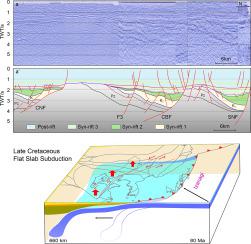当前位置:
X-MOL 学术
›
Gondwana Res.
›
论文详情
Our official English website, www.x-mol.net, welcomes your
feedback! (Note: you will need to create a separate account there.)
New insight into East Asian tectonism since the late Mesozoic inferred from erratic inversions of NW-trending faulting within the Bohai Bay Basin
Gondwana Research ( IF 7.2 ) Pub Date : 2020-03-01 , DOI: 10.1016/j.gr.2020.01.022 Yiming Liu , Lijun Liu , Zhiping Wu , Wei Li , Xin Hao
Gondwana Research ( IF 7.2 ) Pub Date : 2020-03-01 , DOI: 10.1016/j.gr.2020.01.022 Yiming Liu , Lijun Liu , Zhiping Wu , Wei Li , Xin Hao

|
Abstract The stress state and its dynamic background of East Asia, especially that during the late Mesozoic, remain controversial. We analyze the structural evolution of the Bohai Bay Basin (BBB) and it relationship with the regional tectonic history of East Asia. In particular, we focus on the central BBB NW-trending faults that have received little attention due to their inconspicuous structural features. Here we show that the erratic inversion of these NW-trending faults records episodic crustal deformation that is crucial for better understanding the regional tectonism. We find that these faults experienced alternating phases of shortening, stretching and shearing deformation. They initiated as reverse faults during the Late Triassic and reversed to normal faults during the Early Cretaceous. The pre-existing faults determined the development of NW-trending basins, which are synchronous with the peak destruction period of the North China Craton (NCC). The Late Cretaceous marks a stage of regional shortening without magmatism, which we propose to reflect a previously unrecognized period of flat-slab subduction of the Izanagi Plate. During the Early Paleogene (65–40 Ma), the reactivation of the NW-trending faults, likely due to the rollback of the oceanic slab, caused intensive rifting of the basin. During the Late Paleogene (40–23 Ma), they transformed to transtensional faulting due to the north-south oblique stretching from the parallel dextral strike-slip bounding faults. From Neogene, the basin entering its post-rift stage was characterized by the conjugate NE- and NW-trending strike-slip fault systems, likely in response to E-W regional compression.
中文翻译:

从渤海湾盆地内 NW 向断层的不规则反转推断晚中生代以来东亚构造作用的新见解
摘要 东亚特别是中生代晚期的应力状态及其动态背景尚存在争议。我们分析了渤海湾盆地(BBB)的构造演化及其与东亚区域构造历史的关系。我们特别关注中央 BBB NW 向断层,由于其不显眼的结构特征而很少受到关注。在这里,我们表明这些 NW 向断层的不规则反转记录了偶发地壳变形,这对于更好地理解区域构造作用至关重要。我们发现这些断层经历了缩短、拉伸和剪切变形的交替阶段。它们在晚三叠世作为逆断层开始,在早白垩世逆断为正断层。预先存在的断层决定了西北向盆地的发育,与华北克拉通(NCC)的破坏高峰期同步。晚白垩世标志着一个没有岩浆作用的区域缩短阶段,我们认为这反映了以前未知的伊邪那岐板块平板俯冲时期。在古近纪早期(65-40 Ma),可能是由于大洋板块的回滚,NW 向断层的重新活动引起了盆地的强烈裂谷。在古近纪晚期(40-23 Ma),由于平行的右旋走滑边界断层的南北斜向伸展,它们转变为张张断层。从新近纪开始,盆地进入后裂谷阶段的特征是共轭的 NE 和 NW 向走滑断层系统,
更新日期:2020-03-01
中文翻译:

从渤海湾盆地内 NW 向断层的不规则反转推断晚中生代以来东亚构造作用的新见解
摘要 东亚特别是中生代晚期的应力状态及其动态背景尚存在争议。我们分析了渤海湾盆地(BBB)的构造演化及其与东亚区域构造历史的关系。我们特别关注中央 BBB NW 向断层,由于其不显眼的结构特征而很少受到关注。在这里,我们表明这些 NW 向断层的不规则反转记录了偶发地壳变形,这对于更好地理解区域构造作用至关重要。我们发现这些断层经历了缩短、拉伸和剪切变形的交替阶段。它们在晚三叠世作为逆断层开始,在早白垩世逆断为正断层。预先存在的断层决定了西北向盆地的发育,与华北克拉通(NCC)的破坏高峰期同步。晚白垩世标志着一个没有岩浆作用的区域缩短阶段,我们认为这反映了以前未知的伊邪那岐板块平板俯冲时期。在古近纪早期(65-40 Ma),可能是由于大洋板块的回滚,NW 向断层的重新活动引起了盆地的强烈裂谷。在古近纪晚期(40-23 Ma),由于平行的右旋走滑边界断层的南北斜向伸展,它们转变为张张断层。从新近纪开始,盆地进入后裂谷阶段的特征是共轭的 NE 和 NW 向走滑断层系统,









































 京公网安备 11010802027423号
京公网安备 11010802027423号